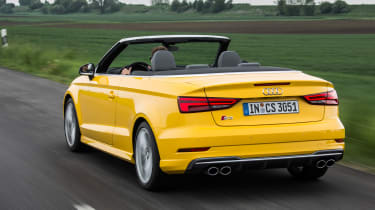Audi S3 (2013 - 2020) review - MPG, CO2 and running costs
Running costs are reasonable, but what makes the Audi S3 really attractive financially is its reputation for slow depreciation
Impressively, the 2.0-litre TFSI in the latest S3 is not only more powerful than the previous model’s engine, but cleaner and more efficient, too. When hooked up to the S tronic transmission, it claims fuel economy of 40.9mpg and 158g/km CO2 emissions for the three-door hatchback and five-door Sportback versions. In comparison, the six-speed manual models were slightly less efficient, with figures of 40mpg and 162g/km.
Go for the S3 Saloon, and you can expect 40mpg economy irrespective of gearbox; the S tronic claims 160g/km of CO2 and the manual emits 164g/km. Meanwhile, the S tronic-only Cabriolet has official figures of 39mpg and 165g/km. The S3 Sportback and S3 saloon cost less than £40,000, so qualify for a standard rate of road tax, and it's worth looking for a post April 2017 car, because these will be around £40 a year cheaper to tax than older models that pay road tax based on CO2 emissions.
As for the S3 Cabriolet, this breaks the £40,000 list price barrier, so has the luxury car surcharge applied to it, which means it'll cost over £300 extra to tax for the first five years of ownership, so looking for a pre-April 2017 car is a good idea to help save on tax costs.
Insurance groups
Most versions of the Audi S3 sit in insurance group 39, apart from the S3 Cabriolet, which is bumped up to group 42. So your annual premiums are going to be expensive – and it doesn't compare that favourably with the BMW M140i, which sits in group 37. The BMW M240i Convertible is rated below the S3 Cabriolet, in group 40.
Depreciation
The Audi S3 has a very strong reputation for holding on to its value. In fact, taking into account the cost of ownership – including fuel and servicing – trade expert CAP claimed in 2014 that you’d be better off buying a new S3 than a year-old one. Either way, it wouldn’t be unreasonable to expect the car to retain a healthy 55 per cent of its purchase price come resale time in three years.




